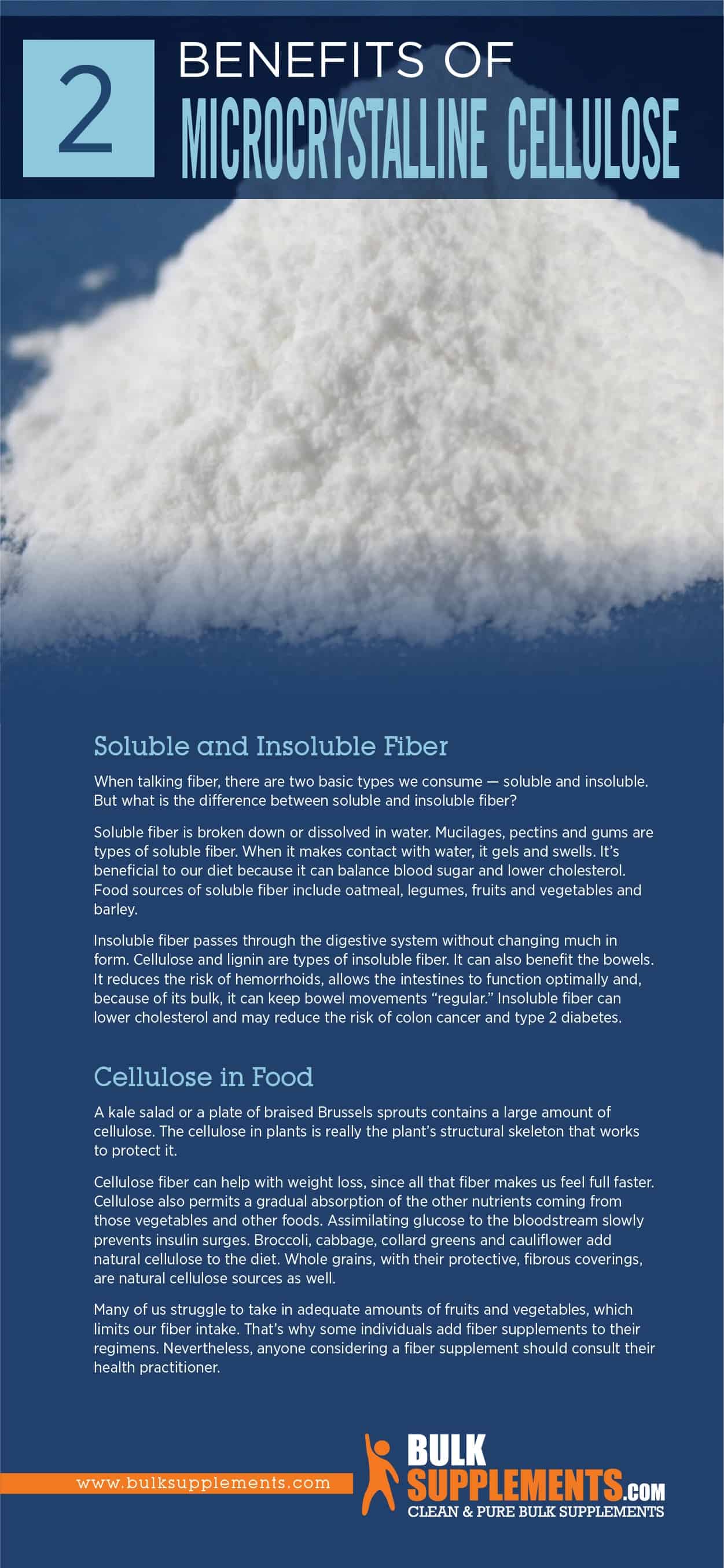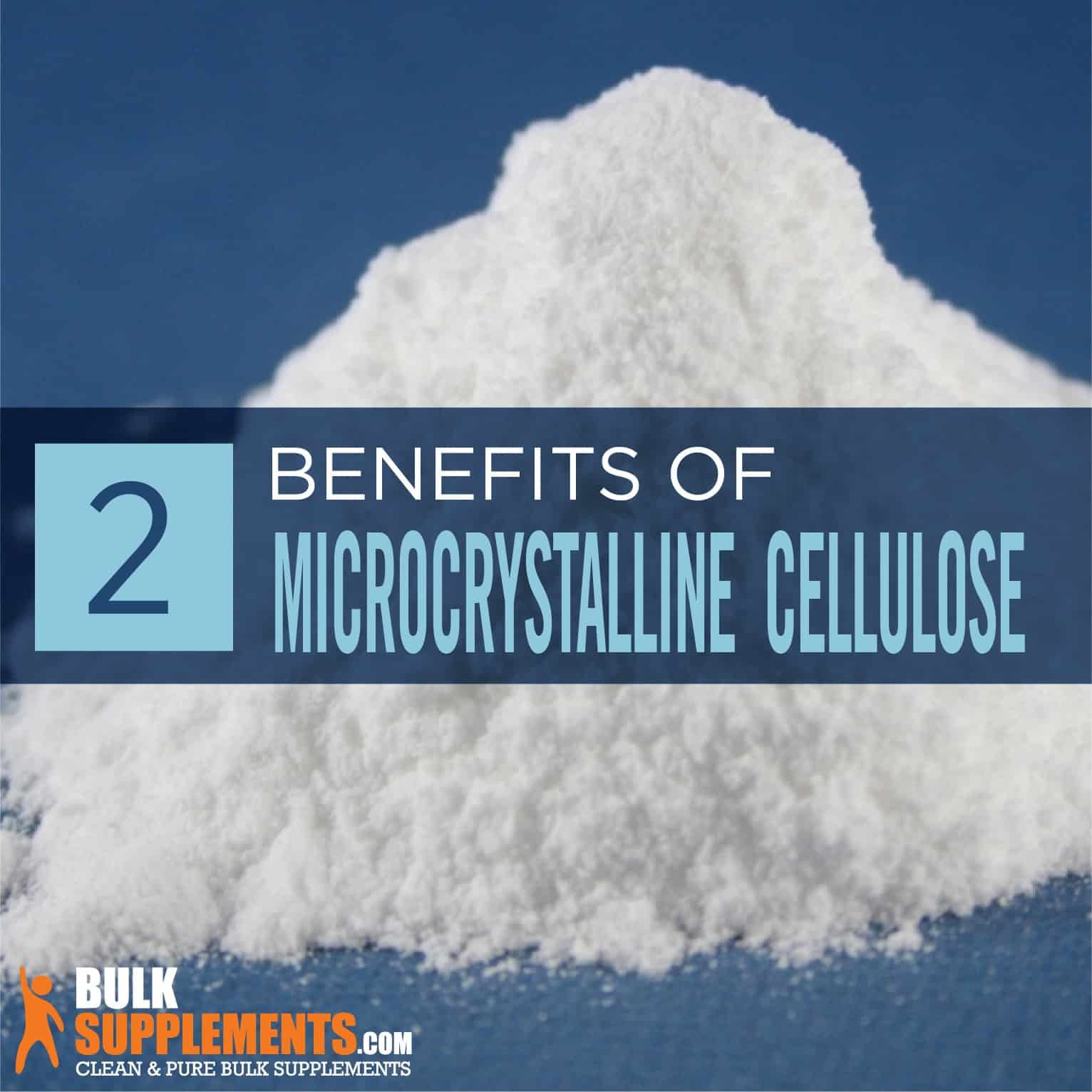What is Microcrystalline Cellulose?
Microcrystalline cellulose (MCC) is non-digestible plant matter in sources like wood pulp and tough plant stalks. These plants are harvested, cleaned and ground to create a fine, white powder. It is called “microcrystalline” because its tiny crystals can only be viewed under a microscope. Microcrystalline cellulose is a common addition to products not for nutritional value, but for various other purposes. And as strange as it may seem to add ground wood pulp to foods or pharmaceuticals, it is safe and legal.
You may find microcrystalline cellulose on ingredient lists under the names powdered cellulose, MCC, cellulose gum or carboxymethylcellulose. Microcrystalline cellulose is often present in supplements, pharmaceuticals and packaged foods, and its unique properties are used for a variety of reasons (x).
Where Does Microcrystalline Cellulose Come From?
Some people are unsure about the thought of having “wood pulp” in food. However, microcrystalline cellulose is not created from recycled industrial pallets. In fact, MCC is carefully processed cellulose from wood or other tough plant parts such as sorghum, cotton linen or hemp (x, x).
Microcrystalline Cellulose in the Pharmacy
If you browse through your bathroom cabinet, you’ll most likely find pills and tablets with microcrystalline cellulose as an inactive ingredient (x). Just a few of these include (x):
- Acetaminophen
- Alprazolam
- Cyclobenzaprine
- Oxycodone
Personal care products may contain microcrystalline cellulose, too. Microcrystalline cellulose is inert on its own and easy to compress. This makes it a perfect ingredient for pharmaceutical products. Technically, microcrystalline cellulose is an excipient — an inactive material that is used as a vehicle for an active substance. MCC adds bulk to the active ingredient, allowing it to be consumed in a deliverable, dosed format. This granular white powder is compressed into tablets, but when it’s ingested, it breaks down easily.
Microcrystalline Cellulose in the Market
Drug companies aren’t the only ones who appreciate the benefits of microcrystalline cellulose. MCC also plays a big role in food production. In fact, MCC has become one of the most popular food additives. Adding microcrystalline cellulose to food can influence its texture without impacting the flavor (x).
MCC can bind and mix easily with water and it has gelling properties. MCC acts as an emulsifier, a product that suspends ingredients within a solution and prevents water from separating out. Adding microcrystalline cellulose can unite two normally resistant liquids (like water and oil) that would separate while sitting on the shelf.
Microcrystalline cellulose acts as a stand-in for higher calorie ingredients. Its cell structure mimics fat and it’s commonly present in reduced fat products. It can also be whipped and thickened in ice cream, whipped topping and desserts, making the food creamy without adding fat. MCC adds bulk and body to food without adding calories, making the consumer feel physically satisfied without overloading their calorie count (x).
Other uses of MCC:
- Adding dietary fiber
- Keeping canned soups and sauces in a stable, semi-liquid state
- Preventing caking and allowing a free-flowing product in shredded and grated cheeses, powdered drinks and spice mixes
Microcrystalline Cellulose in the News
Microcrystalline cellulose as a food additive has been in the news recently (x). Understandably, consumers want to know what is in their food.
Adding fillers into food is not a new idea. Bread makers and other food producers have added wood fibers in foods throughout the industrial age up to modern times. In the 18th century, bread makers tried to feed people inexpensively. Wheat was scarce, but sawdust was plentiful. Since sawmills and grist mills were often located next to each other, it was an easy transition to add sawdust to bread. This bread was cheaper to make and it fed more people.
However, not everyone was happy with the “sawdust bread” and this gave rise to more food regulation. Companies that promoted the purity of their food became more popular (x).
Recently, a larger company that produces Parmesan cheese was involved in a lawsuit for adding too much cellulose to its products. Other cheese manufacturers typically use microcrystalline cellulose in their product in acceptable levels. Fast food chains also use MCC in buns, cheese, shakes, sauces, fries, onion rings and meats — just about everything (x).
Is MCC Safe?
The FDA allows food companies to add cellulose, claiming that it is a harmless, organic additive. Manufacturers are able to include cellulose to contribute up to 4 percent of the total food product (x).
Microcrystalline cellulose in meat products is different, since the USDA regulates meat. The USDA has ruled that manufactured meat products can only contain 3.5 percent microcrystalline cellulose.
Some argue that microcrystalline cellulose is just a redundant filler, but it is more expensive than carbohydrate fillers like sugar and starches. And, unlike starch fillers, MCC isn’t derived from GMO plants. It’s not harvested from fields sprayed with pesticides; it’s gathered from sustainable forests (x).
Cellulose vs. Starch
Both cellulose and starch are commonly added to processed and packaged foods. They are similar because they are structured as glucose-based polymers, which are substances containing like units bonded together (x).
Cellulose is a common, natural polymer. Cotton, wood and paper all contain fiber-rich cellulose. Starch is a polymer as well and the most common carbohydrate in our diets. Potatoes, wheat, rice and corn all contain large amounts of starch.
The glucose units in cellulose are connected by beta linkages and the glucose units in starch are connected by alpha linkages. But what does this mean in everyday terms? It means that you can chew cellulose until the cows come home, but you cannot digest it.
Human bodies don’t have the necessary enzymes to break down and use cellulose. Cows, however, can digest cellulose in tough grasses and plants. They process cellulose with the help of symbiotic bacteria in their four-chambered guts. Termites also carry helpful bacteria with the proper enzymes to break down the wood they consume (x).
By contrast, starch is something we can digest and use. Our body has the enzymes to break down starches into glucose, which can be burned for energy.
Soluble and Insoluble Fiber
When talking fiber, there are two basic types we consume — soluble and insoluble. But what is the difference between soluble and insoluble fiber?
Soluble fiber is broken down or dissolved in water. Mucilages, pectins and gums are types of soluble fiber. When it makes contact with water, it gels and swells. It’s beneficial to our diet because it can balance blood sugar and lower cholesterol. Food sources of soluble fiber include oatmeal, legumes, fruits and vegetables and barley.
Insoluble fiber passes through the digestive system without changing much in form. Cellulose and lignin are types of insoluble fiber. It can also benefit the bowels. It reduces the risk of hemorrhoids, allows the intestines to function optimally and, because of its bulk, it can keep bowel movements “regular.” Insoluble fiber can lower cholesterol and may reduce the risk of colon cancer and type 2 diabetes (x, x, x).
Cellulose in Food
A kale salad or a plate of braised Brussels sprouts contains a large amount of cellulose. The cellulose in plants is really the plant’s structural skeleton that works to protect it.
Cellulose fiber can help with weight loss, since all that fiber makes us feel full faster. Cellulose also permits a gradual absorption of the other nutrients coming from those vegetables and other foods. Assimilating glucose to the bloodstream slowly prevents insulin surges (x). Broccoli, cabbage, collard greens and cauliflower add natural cellulose to the diet. Whole grains, with their protective, fibrous coverings, are natural cellulose sources as well.
Many of us struggle to take in adequate amounts of fruits and vegetables, which limits our fiber intake. That’s why some individuals add fiber supplements to their regimens. Nevertheless, anyone considering a fiber supplement should consult their health practitioner.

Microcrystalline Cellulose Side Effects
Microcrystalline cellulose in certain fiber supplements may cause mild side effects (x). These may include gas, bloating and increased stool production.
If you have Crohn’s disease or a history of bowel obstruction, discuss with a doctor or pharmacist about drug interactions with fiber supplements.
Fiber supplements can lessen the absorption of some medications and reduce blood sugar levels. Anyone taking fiber supplements should begin in small doses to minimize intestinal gas.
The Bottom Line
Microcrystalline cellulose is a common pharmaceutical and food additive. Its inert, flavorless characteristics make it an ideal ingredient for several reasons. Microcrystalline cellulose has properties that deliver medicines in convenient tablets. MCC is also versatile in food products because it can provide bulk and texture and optimize shelf life. Microcrystalline cellulose is also common in fast food products.
High in insoluble fiber, microcrystalline cellulose is often made from tree wood, cotton or plant stalks. Though the FDA has ruled it legal for foods to contain a small amount of MCC, some are concerned about the addition of tree parts in their food. For the time being, however, microcrystalline cellulose will remain a key component of consumer products (x).


